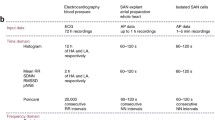Abstract
Despite the widespread use of mice in the investigation of cardiac function, little is known as to what extent cardiac contractile function varies between different murine strains. We have investigated basic contractile function in isolated multicellular right ventricular trabeculae from three commonly used mouse strains (C57BL/6, SV129, and FVBN). Suitable trabeculae (<100 μm thick, >1 mm long) occurred rather frequently in FVBN and SV129 mice (on average about 2 per heart), but only sporadically in C57BL/6 mice (on average only 1 per 3–4 mice). However, using similar sized preparations under experimental conditions closely mimicking those in vivo (37°C and frequencies between 8 and 12 Hz), contractile function was virtually identical. In addition, the magnitude of response to β-adrenergic stimulation was also indistinguishable between the strains. However, at subphysiological frequency, FVBN mice consistently displayed more developed force compared to C57/BL6 and SV129 mice. Furthermore, contractile performance at a subphysiological temperature and frequency, where studies on isolated myocardium often are performed, was also strain-dependent. We conclude that basic contractile function under near physiological conditions is preserved throughout various strains, but subphysiological conditions can have a profound effect on contractile performance. Hence, choice of strain can have important implications for cardiac contractile function under nonphysiological conditions.




Similar content being viewed by others
References
Bers DM (1997) Ca2+ sparks. Jumping the gap from the cell to cardiac muscle. Circ Res 81:636–638
de Tombe PP, ter Keurs HE (1990) Force and velocity of sarcomere shortening in trabeculae from rat heart. Effects of temperature. Circ Res 66:1239–1254
Fewell JG, Osinska H, Klevitsky R, Ng W, Sfyris G, Bahrehmand F, Robbins J, Vornanen M (1997) A treadmill exercise regimen for identifying cardiovascular phenotypes in transgenic mice. Am J Physiol 273:H1595–H1605
Georgakopoulos D, Kass DA (2001) Minimal force–frequency modulation of inotropy and relaxation in in situ murine heart. J Physiol 534:535–545
Janssen PML, de Tombe PP (1997) Uncontrolled sarcomere shortening increases intracellular Ca2+ transient in rat cardiac trabeculae. Am J Physiol 272:H1892–H1897
Janssen PML, Hunter WC (1995) Force, not sarcomere length, correlates with prolongation of isosarcometric contraction. Am J Physiol Heart Circ Physiol 269:H676–H685
Janssen PML, Stull LB, Marban E (2002) Myofilament properties comprise the rate-limiting step for cardiac relaxation at body temperature in the rat. Am J Physiol Heart Circ Physiol 282:H499–H507
Kass DA, Hare JM, Georgakopoulos D, Vornanen M (1998) Murine cardiac function: a cautionary tail. Circ Res 82:519–522
Layland J, Kentish JC (1999) Positive force- and [Ca2+]i-frequency relationships in rat ventricular trabeculae at physiological frequencies. Am J Physiol Heart Circ Physiol 276:H9–H18
Mulieri LA, Hasenfuss G, Leavitt B, Allen PD, Alpert NR (1992) Altered myocardial force–frequency relation in human heart failure. Circulation 85:1743–1750
Raman S, Kelley MA, Janssen PML (2005) Effect of muscle dimensions on trabecular contractile performance under physiological conditions. Pflugers Arch 5:5
Rikke BA, Yerg JE III, Battaglia ME, Nagy TR, Allison DB, Johnson TE (2003) Strain variation in the response of body temperature to dietary restriction. Mech Ageing Dev 124:663–678
Rodriguez EK, Hunter WC, Royce MJ, Leppo MK, Douglas AS, Weisman HF (1992) A method to reconstruct myocardial sarcomere lengths and orientations at transmural sites in beating canine hearts. Am J Physiol 263:H293–H306
Stull LB, Leppo M, Marban E, Janssen PML (2002) Physiological determinants of contractile force generation and calcium handling in mouse myocardium. J Mol Cell Cardiol 34:1367–1376
Sys SU, De Keulenaer GW, Brutsaert DL (1998) Reappraisal of the multicellular preparation for the in vitro physiopharmacological evaluation of myocardial performance. Adv Exp Med Biol 453:441–450 (discussion 451)
ter Keurs HE, Rijnsburger WH, van Heuningen R, Nagelsmit MJ (1980) Tension development and sarcomere length in rat cardiac trabeculae. Evidence of length-dependent activation. Circ Res 46:703–714
Vornanen M (1992) Maximum heart rate of soricine shrews: correlation with contractile properties and myosin composition. Am J Physiol 262:R842–R851
Acknowledgements
This study was supported by a National Scientist Development Award from the American Heart Association 0235045N (to PMLJ) and a National Institutes of Health grant R01 HL44065 (to EM). LS was supported by NIH fellowship training grant 2T32HL07581-16.
Author information
Authors and Affiliations
Corresponding author
Rights and permissions
About this article
Cite this article
Stull, L.B., Hiranandani, N., Kelley, M.A. et al. Murine strain differences in contractile function are temperature- and frequency-dependent. Pflugers Arch - Eur J Physiol 452, 140–145 (2006). https://doi.org/10.1007/s00424-005-0020-y
Received:
Revised:
Accepted:
Published:
Issue Date:
DOI: https://doi.org/10.1007/s00424-005-0020-y




